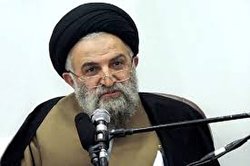 Ayatollah Gharavi said, “The essence of being revolutionary is that one takes a risk for the revolution, meaning he doesn’t see personal issues in the way of defending the revolution.”
Ayatollah Gharavi said, “The essence of being revolutionary is that one takes a risk for the revolution, meaning he doesn’t see personal issues in the way of defending the revolution.” RNA – Speaking at a ceremony where turbans were bestowed upon seminarians in Khorramabad, Ayatollah Sayyed Mohammad Gharavi, a member of the Supreme Council of Islamic Seminaries, offered his congratulations on the birth anniversary of Lady Fatimah al-Zahra, the daughter of the Prophet Muhammad, and said, “The lofty station of Lady Fatimah cannot be understood by just anyone.”
His Eminence added, “The Ahl al-Bayt are the intermediaries of grace and this great lady has an exceptional position. The station of Lady Fatimah is a high station and a role model for all human beings.”
He addressed the new clerics and referred to a narration and said, “A scholar must live with his knowledge and the status of a scholar who acts on his knowledge is like the dignity of the martyrs and the righteous.”
Ayatollah Gharavi added, “Now that we have put on the clerical garments, our duty has become heavier. A clergyman who has put on a turban has a special place among the people and therefore, we must adhere to the customs and traditions of these garment.”
His Eminence stated that a real revolutionary person and seminarian can build others when his manner and behaviour is exemplary for others and noted, “Our revolution is Islamic and we must stand up for Islamic values and act in a way that is effective.”
He said, “The essence of being revolutionary is that one takes a risk for the revolution, meaning he doesn’t see personal issues in the way of defending the revolution.”
Ayatollah Gharavi stated that the observance of the rights of individuals and proper association and coexistence, being astute and having insight are other characteristics that must be taken into consideration by seminarians.
Regarding the turban-bestowing ceremony, Shi’ah clergy wear a white or black turban, a special ankle-length coat called a qaba, with an aba, a loose, sleeveless cloak, which open in front worn over the qaba. The black turban is only worn by a cleric who is a sayyid, someone descended from the Prophet Muhammad.
This garment is considered an honour to wear by the clerics and is only given after several years of seminary studies. It comes with heavy responsibilities and it an honour which is not taken lightly.
Rasa News Agency
112/979